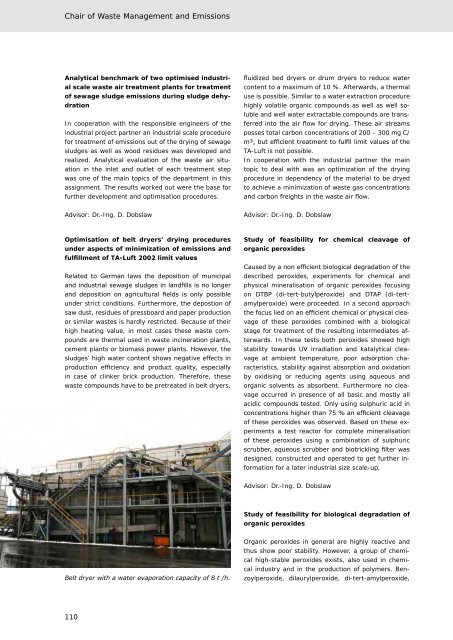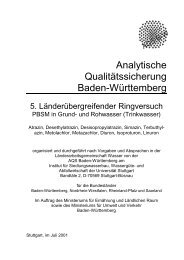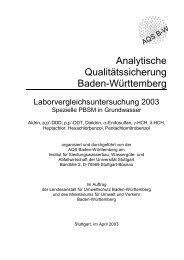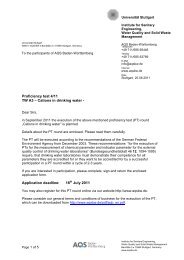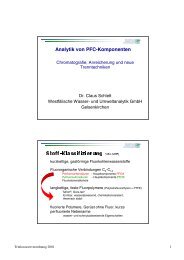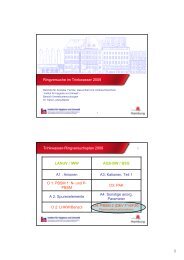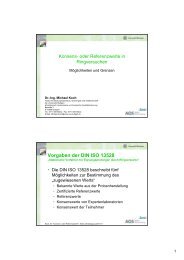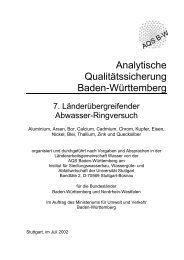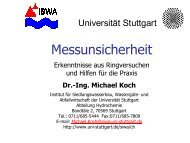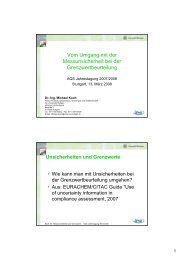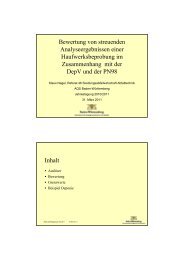Institute for Sanitary Engineering, Water Quality and Solid Waste ...
Institute for Sanitary Engineering, Water Quality and Solid Waste ...
Institute for Sanitary Engineering, Water Quality and Solid Waste ...
You also want an ePaper? Increase the reach of your titles
YUMPU automatically turns print PDFs into web optimized ePapers that Google loves.
Chair of <strong>Waste</strong> Management <strong>and</strong> Emissions<br />
Analytical benchmark of two optimised industrial<br />
scale waste air treatment plants <strong>for</strong> treatment<br />
of sewage sludge emissions during sludge dehydration<br />
In cooperation with the responsible engineers of the<br />
industrial project partner an industrial scale procedure<br />
<strong>for</strong> treatment of emissions out of the drying of sewage<br />
sludges as well as wood residues was developed <strong>and</strong><br />
realized. Analytical evaluation of the waste air situation<br />
in the inlet <strong>and</strong> outlet of each treatment step<br />
was one of the main topics of the department in this<br />
assignment. The results worked out were the base <strong>for</strong><br />
further development <strong>and</strong> optimisation procedures.<br />
fluidized bed dryers or drum dryers to reduce water<br />
content to a maximum of 10 %. Afterwards, a thermal<br />
use is possible. Similar to a water extraction procedure<br />
highly volatile organic compounds as well as well soluble<br />
<strong>and</strong> well water extractable compounds are transferred<br />
into the air flow <strong>for</strong> drying. These air streams<br />
posses total carbon concentrations of 200 – 300 mg C/<br />
m³, but efficient treatment to fulfil limit values of the<br />
TA-Luft is not possible.<br />
In cooperation with the industrial partner the main<br />
topic to deal with was an optimization of the drying<br />
procedure in dependency of the material to be dryed<br />
to achieve a minimization of waste gas concentrations<br />
<strong>and</strong> carbon freights in the waste air flow.<br />
Advisor: Dr.-Ing. D. Dobslaw<br />
Advisor: Dr.-Ing. D. Dobslaw<br />
Optimisation of belt dryers’ drying procedures<br />
under aspects of minimization of emissions <strong>and</strong><br />
fulfillment of TA-Luft 2002 limit values<br />
Related to German laws the deposition of municipal<br />
<strong>and</strong> industrial sewage sludges in l<strong>and</strong>fills is no longer<br />
<strong>and</strong> deposition on agricultural fields is only possible<br />
under strict conditions. Furthermore, the depostion of<br />
saw dust, residues of pressboard <strong>and</strong> paper production<br />
or similar wastes is hardly restricted. Because of their<br />
high heating value, in most cases these waste compounds<br />
are thermal used in waste incineration plants,<br />
cement plants or biomass power plants. However, the<br />
sludges’ high water content shows negative effects in<br />
production efficiency <strong>and</strong> product quality, especially<br />
in case of clinker brick production. There<strong>for</strong>e, these<br />
waste compounds have to be pretreated in belt dryers,<br />
Study of feasibility <strong>for</strong> chemical cleavage of<br />
organic peroxides<br />
Caused by a non efficient biological degradation of the<br />
described peroxides, experiments <strong>for</strong> chemical <strong>and</strong><br />
physical mineralisation of organic peroxides focusing<br />
on DTBP (di-tert-butylperoxide) <strong>and</strong> DTAP (di-tertamylperoxide)<br />
were proceeded. In a second approach<br />
the focus lied on an efficient chemical or physical cleavage<br />
of these peroxides combined with a biological<br />
stage <strong>for</strong> treatment of the resulting intermediates afterwards.<br />
In these tests both peroxides showed high<br />
stability towards UV irradiation <strong>and</strong> katalytical cleavage<br />
at ambient temperature, poor adsorption characteristics,<br />
stability against absorption <strong>and</strong> oxidation<br />
by oxidising or reducing agents using aqueous <strong>and</strong><br />
organic solvents as absorbent. Furthermore no cleavage<br />
occurred in presence of all basic <strong>and</strong> mostly all<br />
acidic compounds tested. Only using sulphuric acid in<br />
concentrations higher than 75 % an efficient cleavage<br />
of these peroxides was observed. Based on these experiments<br />
a test reactor <strong>for</strong> complete mineralisation<br />
of these peroxides using a combination of sulphuric<br />
scrubber, aqueous scrubber <strong>and</strong> biotrickling filter was<br />
designed, constructed <strong>and</strong> operated to get further in<strong>for</strong>mation<br />
<strong>for</strong> a later industrial size scale-up.<br />
Advisor: Dr.-Ing. D. Dobslaw<br />
Study of feasibility <strong>for</strong> biological degradation of<br />
organic peroxides<br />
Belt dryer with a water evaporation capacity of 8 t /h.<br />
Organic peroxides in general are highly reactive <strong>and</strong><br />
thus show poor stability. However, a group of chemical<br />
high-stable peroxides exists, also used in chemical<br />
industry <strong>and</strong> in the production of polymers. Benzoylperoxide,<br />
dilaurylperoxide, di-tert-amylperoxide,<br />
110


